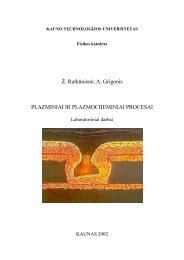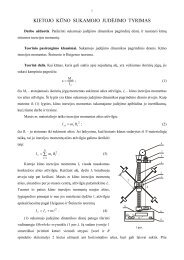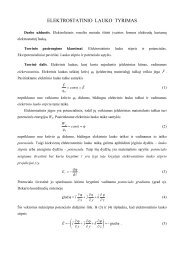PROCEEDINGS OF THE 7 INTERNATIONAL ... - Fizika
PROCEEDINGS OF THE 7 INTERNATIONAL ... - Fizika
PROCEEDINGS OF THE 7 INTERNATIONAL ... - Fizika
Create successful ePaper yourself
Turn your PDF publications into a flip-book with our unique Google optimized e-Paper software.
D. Adlienė et al. / Medical Physics in the Baltic States 7 (2009) 109 - 113<br />
to radiation protection, concerning exposure within the<br />
scope of the relevant special EU Directive [7].<br />
2. Education and training of medical physicists in<br />
Lithuania<br />
In Lithuania, the medical physicist profession has been<br />
regulated since 1992 by law. Qualifications,<br />
competences and responsibilities of medical physicists<br />
are regulated on the basis of the 1995-2001 LR Hygiene<br />
Norms. Under the current system in Lithuania, the<br />
Radiation Safety Centre (RSC), belonging to the<br />
Ministry of Health (SAM), supervises diagnostic and<br />
treatment methods concerning ionizing radiation and<br />
requires that organizations carrying out such procedures<br />
have medical physicists [8]. According to LR Hygiene<br />
Norms (HN 95-2005), health care institutions intending<br />
to treat patients with ionizing radiation must have<br />
medical physicists (1 MP per 400 patients per year). In<br />
countries of comparable size to Lithuania the average<br />
required number of medical physicists working with<br />
ionizing radiation is about 31. Considering that ionizing<br />
radiation is not the only specialization requiring medical<br />
physicists, that every day institutions receive new<br />
equipment and there is a constant need to replace<br />
departing management staff (due to death, retirement,<br />
emigration etc.), Lithuanian health care institutions<br />
need in general no less than 100-150 new specialists in<br />
medical physics.<br />
Only in 2003 did Kaunas University of Technology<br />
(KTU) start to train medical physicists. 25 students had<br />
obtained their MSc degree in Medical physics by 2009.<br />
In practice, every person holding a bachelor’s degree in<br />
physics, engineering or equivalent field can work as a<br />
‘medical physicist’ in Lithuania. Despite the increase in<br />
the number of educated medical physicists, only 8<br />
medical physics professionals were working in<br />
Lithuanian health care institutions in 2008 (2009) as<br />
compared to 23 other specialists working in this area<br />
(Fig 2).<br />
40%<br />
35%<br />
30%<br />
25%<br />
20%<br />
15%<br />
10%<br />
5%<br />
0%<br />
Physicists<br />
Biophysicists+Biologists<br />
Medical Physicists<br />
Electronics engineers<br />
Mechanics engineers<br />
2003<br />
2007<br />
2008<br />
Matematicians<br />
Fig. 2. Qualification of medical physicist staff working in the<br />
Lithuanian health care system<br />
The number of medical physics professionals does not<br />
satisfy the legal requirements and EFOMP<br />
recommendations and does not meet the demand for<br />
these specialists in Lithuanian health care institutions.<br />
110<br />
2.1. MP study program at KTU<br />
Kaunas University of Technology, in collaboration with<br />
Kaunas Medical University, in 2003 introduced a<br />
master’s study program Medical Physics (Reg.No<br />
62102B102) strictly following EU directives 97/43<br />
Euratom (1997-06-30) [7].<br />
The program was organized:<br />
o In collaboration with Swedish and English<br />
universities, the Swedish Radiation Safety<br />
Institute and EFOMP;<br />
o Including the results of the TEMPUS S JEP-<br />
112402-97 project “Joint Baltic Master’s<br />
Courses in Biomedical Engineering and<br />
Physics”<br />
o With participation in the regional TATENA<br />
project RER/6/008 “Building Capacity in<br />
Medical Physics”<br />
The main goal of this program was and is to educate and<br />
train medical physicists for the health care institutions<br />
where ionizing radiation technologies are applied for the<br />
diagnostics and treatment of patients. Medical physicists<br />
are additionally trained to work as radiation protection<br />
officers, if necessary.<br />
The content of the MSc study program “Medical<br />
Physics” is presented in Table 1.<br />
Table 1. Courses at KTU<br />
Courses Credits *<br />
Compulsory courses<br />
Radiation protection and safety 4<br />
Radiobiology 2<br />
Human anatomy and physiology 4<br />
Statistics and mathematical modeling 2<br />
Interaction of radiation with matter 4<br />
Methods of visualization in medicine 4<br />
Recognition and analysis of images 4<br />
Radiation registration methods and detectors 4<br />
Radiation diagnostics 4<br />
Radiation therapy 4<br />
Dosimetry 2<br />
Applied physics of non-ionizing radiation 4<br />
Applied radionuclide physics 2<br />
Research work 12<br />
Master’s thesis 8<br />
Optional courses 4<br />
Nuclear and neutron physics, 4cr<br />
Quantum mechanics, 4cr<br />
Modeling of biomedical systems, 4cr<br />
Radioactive environmental pollution, 4cr<br />
Total 80<br />
* Lithuanian credits. 1 Lithuanian credit = 1.5 ECTS<br />
25 students have graduated from this program. All of<br />
them who were motivated to work as radiation<br />
professionals are employed in Lithuanian health care<br />
and relevant institutions (Fig.3).








